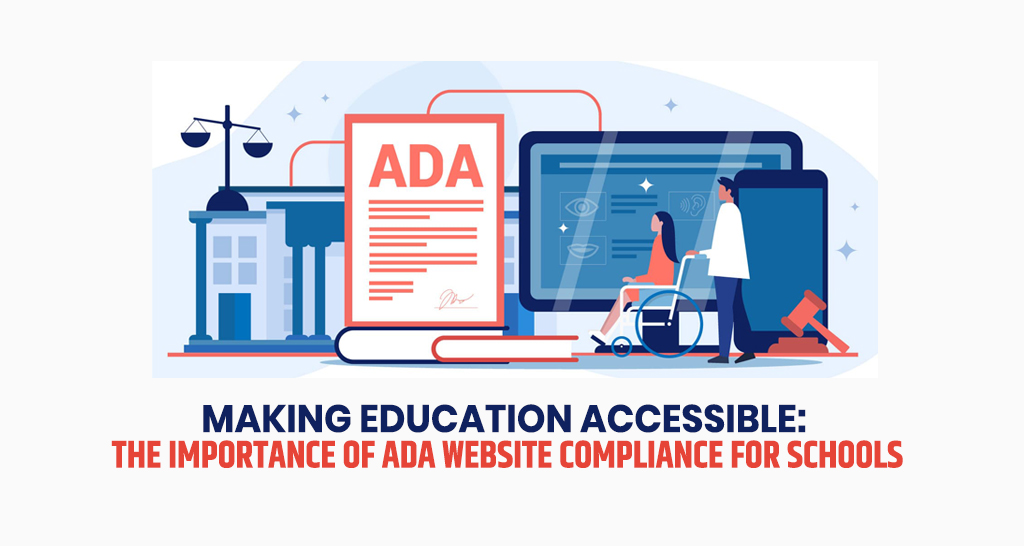The digital age has transformed the way we access information and services, including education. In this connected world, websites have become virtual school doors, offering everything from enrollment information to course materials. Yet, for millions of individuals with disabilities, these doors can remain closed due to inaccessible web design.
The Americans with Disabilities Act (ADA) seeks to remedy this by mandating that websites, particularly those of public entities like schools, be accessible to everyone. This is not merely a legal checkbox but an ethical and practical necessity.
In this article, we will explore the ins and outs, its importance, and the steps schools can take to ensure their digital presence is welcoming to all.
The ADA and Web Accessibility
Enacted in 1990, the Americans with Disabilities Act (ADA) stands as a pivotal civil rights law, designed to protect individuals with disabilities from discrimination across various facets of society.
Under Title II and Title III of this act, educational institutions are considered places of public accommodation. This means they must ensure that their services, programs, and activities – including websites – are accessible to people with disabilities.
To make this mandate actionable, the Web Content Accessibility Guidelines (WCAG) were developed. WCAG serves as the internationally recognized benchmark for web accessibility, providing detailed criteria that, when met, help make web content accessible to a wider range of individuals, including those with visual, auditory, cognitive, and motor impairments.
The core of WCAG revolves around four fundamental principles, often referred to as POUR:
- Perceivable: Information and interactive elements must be presented in ways that everyone can access them, regardless of how they perceive the world.
- Understandable: The information on the website, as well as how to use it, should be clear and easy to figure out for everyone.
- Robust: The content should work well with different web browsers and assistive technologies like screen readers.
Taking the First Steps Towards ADA Website Compliance
Navigating the path to ADA website compliance can feel overwhelming, but schools don’t have to go it alone. Seeking out professional services can significantly ease the burden. You may check here to learn how these experts will help you. They provide comprehensive approaches to ensure your school’s digital presence is welcoming to everyone.
Here’s a quick overview of how these services can help your school:
- Check The Pages: They will look at your content carefully to find any parts that might be difficult for people with disabilities to use. They know exactly what to look for.
- Create a Clear Plan: They will help you write a plan that shows your school cares about accessibility.
- Teach Your Staff: Your staff will learn how to make and maintain your landing pages accessible. This will help everyone work together to ensure that each page is easy to use.
Keep Your Pages Updated: Experts can help you check your site regularly to ensure it stays accessible even when you add new content.
Benefits of Accessible School Websites
Creating a school website that is eay to access to everyone is about more than just following the rules. It’s about doing the right thing and making sure everyone feels welcome. Every student, parent, and staff member should be able to find the information they need on the pages, no matter their abilities. When your web content is easy to use, it shows that the school cares about including everyone.
Easy-to-use information also helps the school reach more people. It helps students with disabilities and their families find information easily, which means the school could attract more students from different backgrounds.
And here’s a bonus: This practice helps everyone, not just people with disabilities. When your web pages are easy to use for people with disabilities, it often makes it easier for everyone else, too. This is because accessible pages have things like clear menus, simple language, and good organization.
Key Areas to Make Your School’s Website More Accessible
- Clear Content: All images should have alt text (text descriptions), so people using screen readers can understand them. Videos should have captions or transcripts, and any content that’s not text (like charts or diagrams) should have a text version.
- Easy Navigation: People should be able to move around the content using just their keyboard without needing a mouse. Headings should be clear and organized, and the overall structure of the website should make sense.
- Good Design: There should be enough contrast between text and background colors so people with low vision can read easily. Text size should be adjustable, and the website should work well on different devices like phones and tablets.
Conclusion
Making school websites accessible isn’t just about following the law. It’s about giving everyone a fair chance to learn. When schools make their content easy to access, they welcome everyone. Technology keeps changing, so schools need to keep up with the latest ways to make the pages easy to access. Let’s work together to make sure everyone can learn online.

